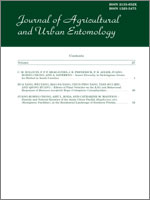Anisaldehyde may be useful as a spatial repellent against Aedes albopictus, and it could play a major role in new repellent technology for mosquito management. This study characterized the delayed effects of anisaldehyde on Ae. albopictus adult host-seeking behavior, feeding behavior, and reproduction. Anisaldehyde was applied as a fumigant (0.25 µg/cm3) during different developmental stages of the mosquito (larvae from 1st instar to pupation, larvae from 1st instar to adult emergence, pupae, and two-day-old adults). Except when treated as pupae, the resulting adult females (at 5 days of age) exhibited significantly lower host-seeking capability and lower repeated-feeding rates than untreated females. Anisaldehyde treatments also significantly reduced the number of eggs and hatchability, and this chemical prolonged the gonotrophic cycle and egg development. These results showed that anisaldehyde acted as a spatial repellent, where it not only reduced host-seeking capability, but also greatly reduced vectoring capacity and reproduction potential, which is significant for mosquito control and disease prevention.
BioOne.org will be down briefly for maintenance on 14 May 2025 between 18:00-22:00 Pacific Time US. We apologize for any inconvenience.
How to translate text using browser tools
1 January 2013
Delayed Effect of Anisaldehyde on Feeding Behavior and Reproduction of Adult Aedes albopictus (Diptera: Culicidae)
Huiling Hao,
Jianqing Dai,
Jingcheng Sun
ACCESS THE FULL ARTICLE
It is not available for individual sale.
This article is only available to subscribers.
It is not available for individual sale.
It is not available for individual sale.
mosquitoes
plant volatiles
spatial repellent





